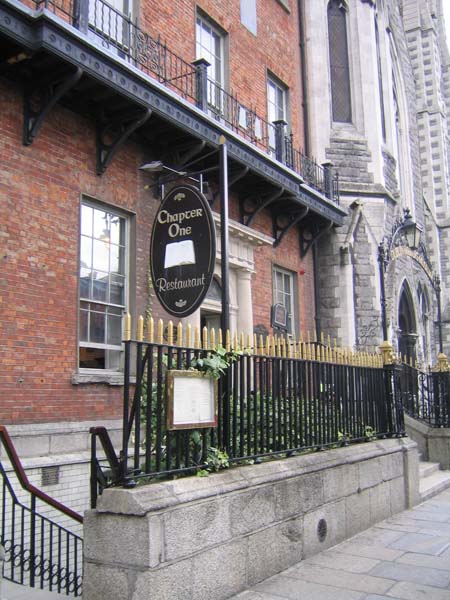
How often, after a truly brilliant meal, have you heard the comment, “Oh if only I could have his recipe….” followed by the sigh suggesting he or she actually believes that, given the right recipe, he or she could re-create the dish just enjoyed. It isn’t so much that I doubt the heartening idiom, “Anyone can Cook.” It’s more that I believe few people realize the depth of effort behind some of their favorite restaurant flavors. It was this belief that drove me today, to pull out my detective pad and pen in order to uncover the origins of some of Chapter One’s most popular dishes. Tuesday, after all, is “stock day,” the perfect day to begin stalking flavors.
To begin, let us define terms. Stock is a cook’s liquid. Stock is, in essence, flavored water. Any combination of fish, meat or poultry bones, vegetable scraps, herbs, and spices might be added to a pot of simmering water in order to produce a useful kitchen stock. In terms of origins, other than the raw ingredients themselves, there is no more basic flavor component in the kitchen than “stock.” Right, any questions?
When I walked into work today the stove tops were already covered with a hubbub of steaming pots. Fat ones, tall ones, even the monster stationary pot in the corner … all the pots were huffing over stock. Tuesday is one of the two fish delivery days each week, so the counters were covered with the scraps and skins of Wild Sea Bass, John Dory, Arctic Char, Hake and scallops. By 9:30 AM each of these bits of seafood had made its way into one of the huffing pots. No bit was wasted!
As I began my morning peeling and chopping, I also began subtly questioning my co-workers. “Eamonn, what is it you’ve got on there?” Eamonn: “That pot there? Oh yea, that’s the stock base for the Veronique … ya know, for the scallops.” AHA! Mental notes were frantically made, “Veronique sauce begins with scraps of cured ham hock, smoked bacon, celery, scallop cords, leeks, fennel, white wine and chicken stock.” Like a fantastic vintage port or sherry, it is not unusual for an especially flavorful stock to be “fortified” by chicken stock, or some other simpler stock. This particular flavor base is especially conniving because everyone knows scallops and pigs were meant for one another (think scallops wrapped in bacon!) Rather than introducing actual pork bits into the dish, this plate incorporates the perfect hint of pig through the sauce….genius!
A little later on I found myself slicing cucumbers near the hot starter station. I watched as Paul shelled dozens of freshly roasted chestnuts and plopped them into some bubbling liquid behind him. “Paul, what did ya drop those chestnuts into?” I asked. “That’s pheasant stock there. It’ll be chestnut soup, though, when I puree these chestnuts in it and pass it through that strainer there.” Scrambling for my notepad must have made him suspicious because he poked a sheet of paper at me and asked,” Did ye want the recipe here?” “Ah right. Thanks, Paul,” I answered sheepishly.
Pheasant Stock:
Bones and carcasses of 10 pheasants sweat in clarified butter.
Add large dice mire piox of fennel, leeks, carrots, garlic, parsley, chives (and any other veg scraps around).
Deglaze with 700 ml red wine vinegar.
Add 15 gallons chicken stock. Bring to a boil and add aromatics …. Star anise, black fennel seed, juniper berries black peppercorns.
So that was the exotic little twist in the chestnut soup that people love … a bit of a mulling spice effect!
If I had several more hours to spend on this topic, I could go on revealing “secret” ingredients like this for nearly every recipe. As it is, I may have exhausted attention spans already. I hope, however, I’ve made my case for the complexity of great flavors.
 In the heat of service, the limited space of the kitchen occasionally displaces two people – the superfluous stagier and, when Ross is actively working, the Chef de Cuisine. We find ourselves relegated to the back kitchen either bailing out under-prepped cooks (most often me) or getting an edge on the next day’s work (most often Cathal). In these quiet moments of business, I have had numerous opportunities to ask Cathal some of my “nonessential” questions.
In the heat of service, the limited space of the kitchen occasionally displaces two people – the superfluous stagier and, when Ross is actively working, the Chef de Cuisine. We find ourselves relegated to the back kitchen either bailing out under-prepped cooks (most often me) or getting an edge on the next day’s work (most often Cathal). In these quiet moments of business, I have had numerous opportunities to ask Cathal some of my “nonessential” questions.











